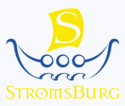Stromsburg, Nebraska
Stromsburg, Nebraska | |
|---|---|
| Stromsburg library Stromsburg library | |
| Nickname: Swede Capital of Nebraska | |
 | |
| Country | United States |
| State | Nebraska |
| County | Polk |
| Government | |
| • Mayor | Elaine K. Westring |
| Area | |
| • Total | 1.0 sq mi (2.6 km2) |
| • Land | 1.0 sq mi (2.6 km2) |
| • Water | 0 sq mi (0 km2) |
| Elevation | 1,677 ft (511 m) |
| Population (2000) | |
| • Total | 1,232 |
| • Density | 1,220/sq mi (471.0/km2) |
| Time zone | UTC-6 (CST) |
| • Summer (DST) | UTC-5 (CDT) |
| ZIP code | 68666 |
| Area code | 402 |
| FIPS code | 31-47465Template:GR |
| GNIS feature ID | 0833862Template:GR |
| Website | www.stromsburgnebraska.com |
Stromsburg is a city in Polk County, Nebraska, United States. The population was 1,232 at the 2000 census.
History
Stromsburg was settled early in Nebraska history. A group of Swedish settlers coming from the town of Ockelbo arrived in the 1860s after several years in Illinois. This group had a leader named Lewis Headstrom, who was a real estate agent. Seeing some similarities to their old Swedish homeland the settlers formed what would be called Stromsburg, named after a section of Ockelbo, Sweden. By the 1880s two brickyards were in operation in the town. Many buildings from ‘native’ brick still stand, including the Viking Center, now a community center that was originally The Opera House; the Cornerstone Bank; two businesses on the east side of the square; and several homes. Brick streets still surround the city square in Stromsburg. A brick Carnegie library was built in Stromsburg in 1918. The downtown area of Stromsburg has a town square in its center. This square forms a park, with lawns and mature trees, where festivals and events are held. In the center of the square is a two story Swedish style building made of brick with decorative toll painting and the phrase "Välkommen" (Swedish for "Welcome").
In 1966 the Nebraska Governor came to Stromsburg for the Swedish Festival proclaiming it the "Swede Capital of Nebraska", a title that the community still claims.
Stromsburg Public School has serviced the community since 1887. In 2002, the Stromsburg district consolidated with Benedict, Nebraska to form Cross County Community School, which serves the educational needs of the community's children.
Geography
Stromsburg is located at 41°6′56″N 97°35′37″W / 41.11556°N 97.59361°WInvalid arguments have been passed to the {{#coordinates:}} function (41.115580, -97.593551)Template:GR.
According to the United States Census Bureau, the city has a total area of 1.0 square miles (2.6 km²), all of it land.
Demographics
As of the censusTemplate:GR of 2000, there were 1,232 people, 487 households, and 320 families residing in the city. The population density was 1,214.2 people per square mile (471.0/km²). There were 533 housing units at an average density of 525.3/sq mi (203.8/km²). The racial makeup of the city was 99.19% White, 0.08% Native American, 0.08% Asian, 0.16% from other races, and 0.49% from two or more races. 0.65% of the population were Hispanic or Latino of any race.
There were 487 households out of which 27.1% had children under the age of 18 living with them, 59.1% were married couples living together, 4.3% had a female householder with no husband present, and 34.1% were non-families. 31.8% of all households were made up of individuals and 19.9% had someone living alone who was 65 years of age or older. The average household size was 2.32 and the average family size was 2.92.
In the city the population was spread out with 22.9% under the age of 18, 6.3% from 18 to 24, 20.5% from 25 to 44, 18.8% from 45 to 64, and 31.7% who were 65 years of age or older. The median age was 45 years. For every 100 females there were 92.8 males. For every 100 females age 18 and over, there were 81.0 males.
The median income for a household in the city was $34,250, and the median income for a family was $45,250. Males had a median income of $32,132 versus $18,600 for females. The per capita income for the city was $17,235. About 4.0% of families and 4.5% of the population were below the poverty line, including 2.9% of those under the age of 18 and 3.5% of those 65 and older.
References

